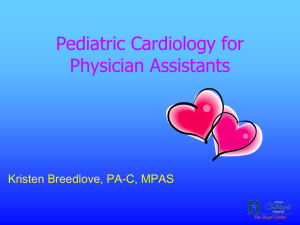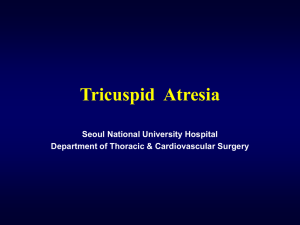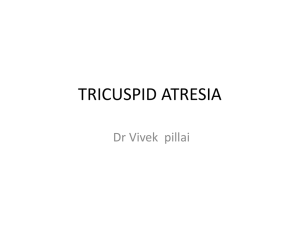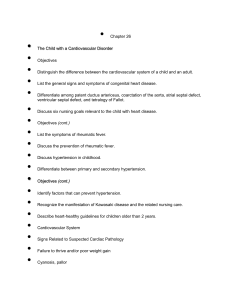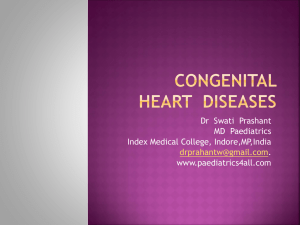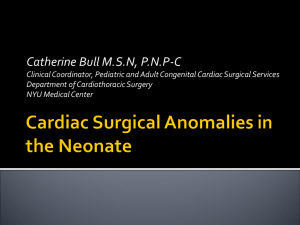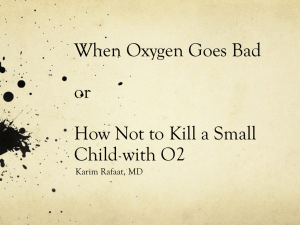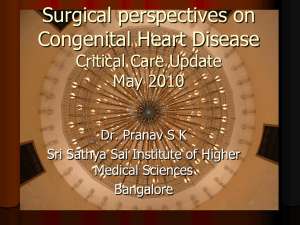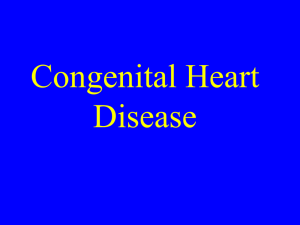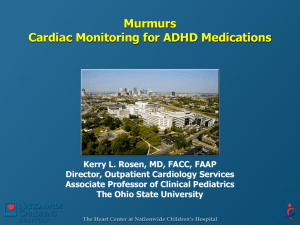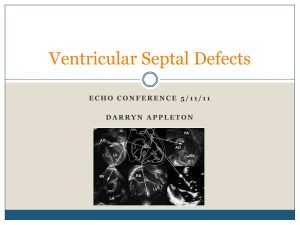congenital_heart_dz_revised_1_carter
advertisement
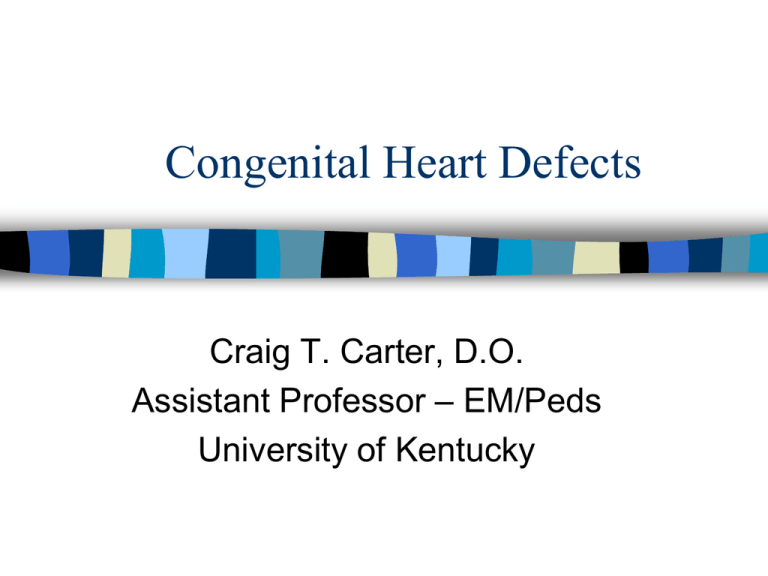
Congenital Heart Defects Craig T. Carter, D.O. Assistant Professor – EM/Peds University of Kentucky A nurse approaches you - “Doctor, Doctor” - a kid just checked in with a history of Hypoplastic Left Heart syndrome – What is that again??” You reply ….. “ I need to go to the bathroom, as soon as I get back, I will tell you all about it....” So you sit and think….. And think some more…. Back to Basics-Fetal Circulation Four shunts of blood flow : placenta, ductus venosus, foramen ovale and ductus arteriosus Back to Basics-Fetal Circulation Changes after birth: Shift of blood flow for gas exchange, from the placenta to the lungs. Closure of ductus venosus :no placenta increase in pulmonary blood flow functional closure of foramen ovale (increased LA pressure) Closure of ductus arteriosus (^O2) Newborn Cardiac Exam Vital signs: RR, HR, BP respiratory effort color palpate point of maximal impulse (PMI) of heart palpate pulses of all extremities auscultate Case 1: 2 day old infant 2 day old baby girl is being examined for discharge physical. Vitals: HR:120 RR:40 BP: r arm 75/40 Gen : low hairline, webbed neck, edemetous dorsum of feet Case 1: cardiac exam Normal PMI, no thrill No hepatosplenomegally unable to palpate pulses in lower extremities BP’s all four extremities: both legs systolic BP lower 40/30 Case 1: Auscultation S2 splits normally ejection click systolic ejection murmur III/VI at the URSB and LLSB systolic murmur radiates to the back early diastolic decrescendo murmur at 3LICS Case 1: What do you think is the congenital defect? Case 1: What further evaluation do you need? Coarctation of Aorta (COA) Coarctation of Aorta (COA) Incidence: 8% of all congenital heart defects Turner’s syndrome: 30% have COA Preductal: 40% associated with other cardiac defects,symptomatic early in life Postductal: less likely to have symptoms early COA EKG: LVH (but may be normal in 20%) X-rays: heart size may be normal or slightly enlarged Rib notching in older children Echo: can see narrowing Bicuspid aortic valve Doppler:disturbed flow COA complications COA can cause CHF, HTN (intracranial bleeding,hypertensive encephalopathy) Bicuspid aortic valve: stenosis or regurg LV failure infective endocarditis Preductal COA in Newborn 80% of infants with preductal COA develop CHF by 3 months of age! Symptoms of CHF: poor feeding, poor weight gain, dyspnea in first 2-6 weeks of life. Case 2: Two week old with murmur Two week old infant, who you saw as a newborn with normal exam, now is noted to have a heart murmur. PMI LSB, not hyperdynamic pulses equal all extremities No HSM Case 2: Cardiac exam Grade III/VI holosystolic murmur at LLSB Case 2: What would you like to do next? EKG: LVH,LAH Blood pressures all four extremities Xray: look for cardiomegally and increase in pulmonary vascularity oxygenation Echo: VSD Ventricular Septal Defect (VSD) The most common form of congenital heart disease: 20-25% may be located in different anatomical locations may be associated with many other cardiac defects ( in many cases essential for survival) may be small or large (can cause CHF) Case 3: One day old infant One day old infant with tachypnea and cyanosis Gen: cyanotic RR:65, HR 140, BP 40/20 pulse ox on RA: less than 80 Case 3: Respiratory and Cardiac Lungs clear, no retractions, RR rapid Cardiac: PMI at LSB pulses palpable all extremities S2 single and loud. No heart murmur. What would you like to do? ABG: before oxygenation Give 100% O2 and then repeat ABG EKG, 4 extremity BP CXR Results of ABG Before O2: Pa O2 40 PH: 7.15,PaCO2 30 and After 100% O2: PH: 7.12, PaCO2 25 and PaO2 50 Transposition of Great Arteries Transposition of Great Arteries 5% of all congenital heart defects Aorta arises anteriorly from RV, PA arises posteriorly from LV defects (VSD,ASD,PDA) that permit mixing of the two circulations are necessary for survival TGA: ABG:hypoxemia is unresponsive to O2 EKG: RVH X-rays: egg-on-astring silhouette cardiomegally with increased pulmonary vascularity Echo: PA from LV associated anomalies:VSD,ASD ,PDA Immediate Treatment Prostaglandin E1 to reopen PDA Oxygen cardiology/surgery referral DDX of Cyanotic Heart Dz Transposition of the Great Arteries Tetralogy of Fallot Total Anomalous Pulmonary Venous Return Tricuspid Atresia Pulmonary Atresia Truncus Arteriosus Other congenital cyanotic defects Ebstein’s anomaly single ventricle Double-outlet right ventricle (depends on associated defects…if cyanotic or not) Tetralogy of Fallot Tetralogy of Fallot (TOF) Large VSD RV outflow obstruction right ventricular hypertrophy overriding of the aorta Tetralogy of Fallot 10% of all congenital heart defects The MOST COMMON CYANOTIC cardiac defect beyond infancy TOF: physical exam Varying degrees of cyanosis and clubbing systolic thrill LSB S2 single with ejection click loud III-V/VI SEM LSB continuous murmur of PDA TOF EKG: RAD, RVH Xray: “boot-shaped” heart (hypoplastic MPA) Echo: image of four defects associated Tetralogy of Fallot TOF complications Hypoxic spells growth retardation with severe cyanosis brain abscess and CVA infective endocarditis polycythemia Hypoxic Spell ( “TET Spell” Paroxysm of hyperpnea (rapid and deep) irritability and prolonged cry increasing cyanosis decreased intensity of heart murmur (may lead to limpness, convulsion,CVA or death) Treatment of “TET Spell” Knee-chest (squat )position morphine sulfate treat acidosis oxygenation Total Anomalous Pulmonary Venous Return One percent of all congenital heart defects Defect: no direct communication between the pulmonary veins and the left atrium (they can drain: supracardiac,cardiac,infracardiac or mixed) Total Anomalous Pulmonary Venous Return TAPVR findings S2 widely split and fixed S3 or S4 gallop SEM: III-IV/VI middiastolic rumble at LLSB Xrays: cardiomegally “Snowman” Echo can define anatomy EKG:RAD Tricuspid Atresia 1-2% of all congenital heart disease in infancy tricuspid valve is absent and RV is hypoplastic associated defects of VSD,ASD or PDA are necessary for survival Tricuspid Atresia Tricuspid Atresia: findings Exam: cyanosis S2 single, often syst murmur of VSD, and occ of PDA present early CHF Tricuspid Atresia EKG: superior QRS between O and -90 LVH Pulmonary vascularity is decreased Echo: defines minimal RV, and large LV Pulmonary Atresia Less than 1% of congenital heart diseases valve is atretic, RV cavity is hypoplastic need other defects: ASD,PDA for survival Pulmonary Atresia Pulmonary Atresia: findings PE: S2 is single murmur of PDA EKG: normal axis,LVH Xray: decreased pulmonary vascularity Echo:atretic pulmonary valve and hypoplastic RV Pulmonary Atresia Prostaglandin E1 cardiac surgery Truncus Arteriosus Less than 1% of all congenital heart Dz Only a single arterial trunk leaves the heart and gives rise to the pulmonary, systemic and coronary circulations large VSD is always present Truncus Arteriosus PE: cyanosis wide pulse pressure and bounding pulses harsh VSD murmur LSB EKG:normal axis,LAH Xrays: cardiomegally and increased pulm vascularity 50% R aortic arch Echo:single great artery,VSD Hypoplastic Left Heart Hypoplastic Left Heart Hypoplastic left heart syndrome refers to underdevelopment of the left side of the heart. This syndrome may include: – Small aorta: This is the major blood vessel from the left ventricle to the body. Hypoplastic Left Heart May Include: – Aortic valve atresia (absence): This valve normally opens and closes to let blood flow from the left ventricle to the aorta. When atresia is present, there is no connection between the left ventricle and aorta, and no forward blood flow. – – Mitral valve stenosis or atresia: This valve normally opens and closes to let blood flow between the left atrium and left ventricle. Stenosis causes little blood flow; atresia causes no blood flow. Either atresia or stenosis may be present.
